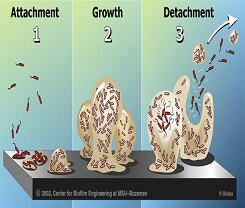
What is a Biofilm?
A biofilm is a congregation of surface-associated microbial cells that are encapsulated in polymeric substances that form an extracellular matrix.
How are Biofilms formed?
Biofilm forms when certain microorganisms adhere to a surface of an object in a moist environment and begin to reproduce. These microorganisms form an attachment to the surface of the object by secreting a slimy, glue-like substance. These biofilm surfaces can include evaporative cooling tower fill material, heat exchangers, along with cooling water sections and pipelines.
Why are biofilms a problem?
Biofilm problems include; decreased equipment efficiency and increased corrosion of equipment. Microbiologically induced corrosion (MIC) rapidly destroys capital equipment through pitting. Biofilm deposits are better insulators than almost any scale type, and this increases energy costs. In addition to high economic loss, biofilm formation may also pose a serious health risk associated with the presence of pathogens including species of Legionella and free-living protozoa.
Biofilm Remediation through the use of AssetGuard® Foul Out
The objectives for removing biofilm include removing it from the surface, breaking down the community into small components via detergents, surfactants and mechanical action. Complete destruction and cell death can be gained through the use of AssetGuard® Foul Out in combination with an EPA registered biocide.
AssetGuard® Foul Out is a unique, proprietary dispersant and penetrant that is used to remove biofilm or organic deposits from heat transfer surfaces prior to application of a registered biocide. The removal of sessile bacteria dramatically improves heat transfer, saves energy and limits the damage caused by microbial induced corrosion (MIC). Additionally, once removed and dispersed, the biofilm organisms can be more effectively destroyed using a registered biocide.
AssetGuard® Foul Out is a formulated organic dispersant and penetrant that can be used in operating open recirculating and closed loop systems. This material is designed to penetrate and remove organic or biological material from heat transfer surfaces, restore energy efficiencies and reduce corrosion rates
The benefits of using AssetGuard® Foul Out include; the removal of biofilm to dramatically increases heat transfer and lowers energy costs, reduced corrosion rates which extends equipment life and lowers capital expenditures over time. Additionally, there is no need to pre-bleed the system to be treated since AssetGuard® Foul Out is not affected by recirculating systems operating at a higher pH. Finally, AssetGuard® Foul Out reduces waste stream compliance issues due to favorable environmental profile and is easy to use since it is highly compatible with all cooling programs and not affected by organics, ammonia or hydrogen sulfide.




